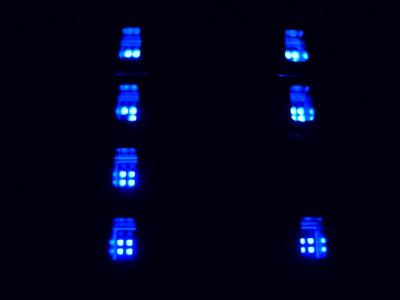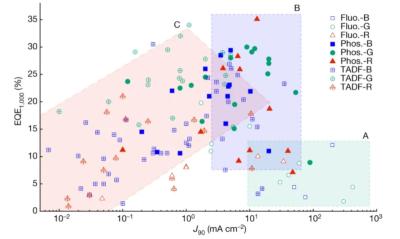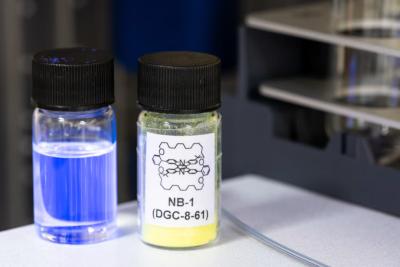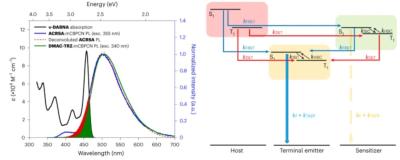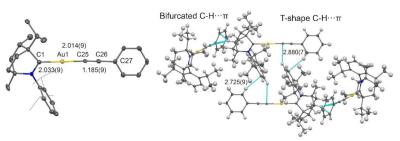TADF OLED emitters, introduction and market status - Page 2
Two research groups show that it is possible to produce a high-performance pure blue MR-TADF OLED emitter without the need for an assistant dopant
Researchers from the Universities of St Andrews, Kyoto and Kyushu have coincidentally developed state-of-the-art multi-resonant TADF (MR-TADF) OLED emitters, based on a helical boron-nitrogen-oxygen doped nanographene design.
In these multiple studies, the researchers have shown that it is possible to obtain deep blue, narrowband emission, very fast reverse intersystem crossing rates constants, and high-efficiency vacuum-deposited OLEDs.
Researchers explain TADF efficiency roll off, to assist material developers in optimizing TADF emitters
Researchers from the University of St. Andrews in the UK, led by Professor Ifor Samuel and Professor Eli Zysman-Colman, identified the key processes controlling the efficiency of TADF OLED emitters under high brightness. This could assist material develops on their quest to design materials that maintain high efficiency at high brightness.
The researchers explain that OLEDs have lower efficiency at higher brightness, and in many TADF materials, the efficiency roll-off is severe, so that the high efficiencies achieved at very low brightness are not maintained at higher brightnesses needed for displays or lighting applications. For the first time, the researcher identified the key processes controlling the triplet population, and propose a figure of merit for efficiency roll-off.
Xiaomi and Lumilan jointly launch an OLED materials R&D project
Xiaomi announced a strategic partnership with Lumilan, an OLED materials developer. Lumilan, with support from Xiaomi, built a new R&D lab in Ningbo, China, to develop new materials targeting smartphone display applications.
Xiaomi aims to get early access (or perhaps exclusive access) to novel OLED material to enhance its competitiveness. It is likely that the two companies aim to develop new OLED stack materials and perhaps new OLED emitters (Lumilan already develops TADF emitters).
UK researchers develop promising new hyperfluorescence blue OLED materials
Researchers from the UK's Northumbria, Cambridge, Imperial and Loughborough universities developed a new Hyperfluorescence OLED emitter system based on a new molecular design, which is highly efficient and simple to produce.
The researchers explain, that in Hyperfluorescence systems, the elimination of the Dexter transfer to terminal emitter triplet states is the key towards OLED efficiency and stability. Current devices rely on high-gap matrices to prevent Dexter transfer, which unfortunately leads to overly complex devices from a fabrication standpoint. The researchers developed a novel molecular design in which ultranarrowband blue emitters are covalently encapsulated by insulating alkylene straps.
Researchers from Durham University use long-forgotten OLED emitter molecules to enable highly efficient hyperfluorescence OLED devices
Researchers Durham University, led by Professor Andrew Monkman, discover new OLED emitters that offer high performance in a hyperfluorescence emission system. The main new material, a molecule called ACRSA, was found to triple the efficiency of hyperfluorescence OLED devices.
These OLED emitters aren't actually new - they were studied years ago, but were found to be poor emitters. That was true when used as OLED emitters, but when used in a hyperfluorescence system (which combines both fluorescent and TADF emitters), these were surprisingly efficient. The ACRSA emits a green emission, but deep blue light emission can be achieved by transferring ACRSA's energy to a blue terminal emitter. This approach reduces exciton energy compared to direct blue emission in devices, allowing more stable, longer-lasting blue OLEDs.
Single-layer TADF OLEDs outperform the best multi-layer device in both efficiency and lifetime
In 2023, we reported on research conducted at Germany's Max Planck Institute, led by Prof. Paul W.M. Blom, that looks into single-layer OLED devices. In such devices, a single TADF OLED emitter layer is sandwiched between two electrode - a much simpler design compared to commercial OLED devices that use multilayer stacks, sometimes with 10 or more layers. The researchers the the MPI say that in fact it is possible to develop highly efficient OLEDs with just the TADF emitter - and have demonstrated 100% IQE single-layer devices, with an EQE of 27.7%.
Prof. Blom's group continues to improve its single-layer TADF OLED device, and have now reported that by employing a recently developed trap-free large band gap material as a host for the DMAC-BP OLED emitter, a nearly balanced charge transport is achieved. The device achieves a record power efficiency for DMAC-BP TADF OLEDs of 82 lm/W - surpassing the best reported multilayer power efficiencies of 52.9–59 lm/W. This is due to the lower operating voltage. The single-layer device reaches an external quantum efficiency (EQE) of 19.6%, which is only slightly lower than the reported EQEs of 18.9–21% for multilayer devices. In addition to the high power efficiency, the operational stability is greatly improved compared to multilayer devices and the use of conventional host materials in combination with DMAC-BP as an emitter.
Kyulux raises $28.6 million, is on track to achieve full-scale mass production of its HF/TADF emitter system by 2025
Kyulux announced that it has raised $28.6 million USD in its Series C funding round, led by El Camino Capital and the MCP Group. This brings Kyulux total funding so far to $86 million USD.
A part of the Kyulux team based in Fukuoka, Japan
Kyulxu says that it will use the newly raised funds to further accelerate its product development, strengthen its IP portfolio and achieve full-scale mass production of its emitter system by 2025, with its affiliated chemical companies.
Researchers develop promising near-UV CMAc OLED emitters
Researchers from the University of Manchester, led by Prof. Alexander Romanov, developed a promising new Carbene-Gold-Arylacetylide (CMAc) OLED near UV emitter type. The researchers also detail a strategy to develop longer device lifetimes for such emitters.
The new emitter exhibits an efficiency of 1% EQE, and a lifetime of 20 minutes at a practical brightness of 10 nits (LT50). This is low compared to commercial OLEDs - but it is actually quite outstanding for such an emitter, and the researchers say that this is among the longest lifetimes for a near UV-OLED at a practical brightness ever reported. In addition, organic fluorescent and TADF emitters rarely exceed 1% EQE at practical brightness.
Noctiluca signs an OLED TADF emitter evaluation agreement with a leading consumer electronics company, likely to be Apple
Poland-based TADF OLED emitter developer Noctiluca announced that it has signed an Evaluation License Agreement with a leading consumer electronics maker, based in California. In fact, Noctiluca says that its partner is the world's largest consumer electronics company, that has several products that utilize OLED displays.
It's likely that Noctiluca's partner is Apple, that is interested in testing the company's emitters. According to Noctiluca, its partner will test the materials at its R&D facility and laboratory in Taiwan. This is likely to be an early stage testing agreement, but still a very interesting development.
Researchers design the world's highest-efficiency narrow-emission deep-blue TADF OLED emitter
Researchers from Korea's KAIST institute, in collaboration with Gyeongsang National University developed a new TADF OLED deep-blue emitter molecule that achieves an EQE of 33%. Combined with a fluorescent emitter to create a hyperfluorescence system, the researchers achieved an EQE of 35.4%, with mitigated efficiency roll-off. The researchers say that this is the world's highest-efficiency narrow-band deep-blue TADF OLED emitter.
To develop the new emitter the researchers introduced sterically hindered peripheral phenyl groups to boron-based TADF emitter. The resulting material, o-Tol-ν-DABNA-Me, offers a pure narrowband emission that is far less sensitive to concentration compared to standard TADF emitters.
Pagination
- Previous page
- Page 2
- Next page
